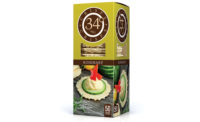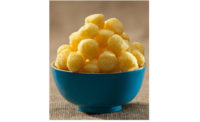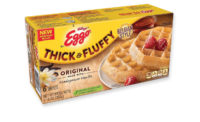The frozen snacks and appetizers category is seeing growth as consumers ask for—and brands attempt to deliver—bold, international flavors to complement traditional, tried-and-true favorites. As always, millennial consumers remain vital to the success of this segment of frozen foods.
Overview | Chips | Puffed/Extruded Snacks | Popcorn | Snack Mixes & Nuts | Tortilla Chips | Pretzels | Frozen Snacks | Crackers
Brands are also taking small steps toward slightly improved nutritional profiles to help build appeal. Expansion into breakfast—often with protein-rich products—is likewise helping breathe new life into the freezer case.
Market data
Dollar sales of the frozen appetizers/snack rolls segment grew by 2.34 percent for the 52 weeks ending April 17 to $2.0 billion, per IRI, Chicago. Top dollar sales growth was at Nestlé, up 87.65 percent to $49.2 million. Private label was also up, rising 12.83 percent in dollar share to $147.1 million. Schwan Food Co. also saw notable growth, up 12.74 percent in dollar sales. General Mills leads the segment with $553.1 million in sales for the year.
The top-selling brand among frozen appetizers and snack rolls is Totino’s Pizza Rolls, a General Mills brand, at $530.9 million, up a slight 0.66 percent for the 52-week period, per IRI. Other top-sellers include El Monterey taquitos from Ruiz Foods (up 8.60 percent to $191.0 million) and Delimex taquitos (up 5.24 percent to $138.3 million). Private label frozen appetizers and snack rolls also saw dollar sales growth, up 12.83 percent to $147.1 million.
A couple of smaller brands experienced rapid growth during the year ending April 17. The Schwan Food Co. brand Pagoda, specializing in Asian appetizers, saw sales rise 453.3 percent to $50.5 million in sales, while IRI reports Nestlé Hot Pockets dollar sales up 1,378.8 percent, to $30.0 million in sales.
Looking back
Nestlé’s Hot Pockets brand recently rolled out a Bites version of its traditional Hot Pockets line with snack time in mind. Nestlé then followed with a line of Hot Pockets Food Truck Bites that come in several flavors that reflect the global fusion and overall experimental cuisine of food trucks, says Kristin Minihan, marketing and business development associate, Nestlé Professional, Solon, OH. Examples include Fiery Jalapeño Lime Chicken and Spicy Asian-Style Beef. “We brought in chefs from food trucks and looked at the trends,” she says. Other flavors in the Food Truck Bites line include Smokin’ Bacon BBQ Recipe Burger and Triple Cheesy Bacon Melt.
Food trucks can test new, innovative flavors on a smaller scale, notes Laura Hardin, communication manager, Nestlé Professional. “We know that global flavors are trending,” she says. “And we know that millennials want to try authentic, global flavor fusions. We’re trying to address those desires of millennials and fit them into a convenient package.”
Millennials and other consumers are also demanding healthier options in snacks, which has led brands like Hot Pockets to work to reduce levels of ingredients like sodium and sugar, Minihan says. All Hot Pockets and Lean Pockets products have clear, front-of-pack (FOP) nutritional legends indicating calories, fat, sodium, sugar, protein and calcium per serving.
The Hot Pockets Snack Bites line comes in Pepperoni Pizza, Hickory Ham & Cheddar, Four Cheese Pizza and Cheesy Beef Nacho. The line has also expanded to include Breakfast Bites, made with a biscuit crust, in Bacon, Egg & Cheese; Ham, Egg & Cheese; and Sausage, Egg & Cheese.
Other brands across frozen snacks and appetizers have expanded into breakfast. Earlier this year, the Kraft Heinz Co. introduced Ore Ida Bagel Bites Breakfast products, available in Bacon, Egg & Cheese and Bacon, Sausage & Cheese.
The El Monterey brand from Ruiz Foods also offers a breakfast options with its Egg, Bacon & Cheese Breakfast Taquitos.
All of these breakfast products from Nestlé, Kraft Heinz and Ruiz Foods include “Good Source of Protein” FOP messaging.
Schwan Food Co. has seen growth in its Pagoda brand snacks due to consumer shifts toward more flexible eating habits with more mini-meals, a trend driven primarily by millennials, says Tim Goldsmid, senior brand marketing director, Schwan’s Consumer Brands, Minneapolis. Growth is also tied to a millennials’ desire to explore global flavors.
In 2015, after a period of decline in the Asian snack subcategory, Pagoda focused on “renovation” of its core product, egg rolls, with updated packaging calling out the brand’s 100 percent white meat chicken, freshly chopped vegetables, bold sauces and egg roll wrapper made from scratch, Goldsmid says. This has helped fuel growth in the segment.
Going forward, Pagoda plans to boost the fortunes of its other Asian snacks—Cream Cheese Wontons, Pork Potstickers, Chicken Potstickers and Crab Rangoon—all with its core millennial consumers in mind. “We will be using high-quality ingredients and taking out ingredients that don’t fit with the brand or our consumer,” Goldsmid says. This is part of an overall “Ingredient Simplicity” initiative at the company.
“Consumers are now, more than ever, looking for ingredients they recognize and can find in their own pantry, even in the indulgent items they crave,” says Goldsmid. “It’s vitally important to listen to consumers and refresh ingredient panels that don’t fit what our consumers want, but doing so in a way that does not compromise the taste and quality.”
Looking ahead
Ardent Mills, Denver, has seen the trend toward better-for-you reach the snack category, even if it wasn’t necessarily at the front lines of that movement, says Zachery Sanders, marketing director for the company.
“Historically, snacks of all kinds were immune to the whole better-for-you eating thing,” says Sanders. However, people want fresh food. “More consumers want to know more about their food sourcing and processing,” he says. “Using high-quality, less-processed ingredients can cast frozen foods in a new and slightly better-for-you light.”
Such shifts can include using whole, sprouted and ancient grains in dough-based frozen snacks like pockets, mini calzones and empanadas, bagel bites and flatbreads, Sanders says. Top ancient grains seeing use today include spelt, sorghum, quinoa and teff, while millet, chia, buckwheat and amaranth are emerging. “These grains continue to grow in usage and are seen as easy additions into dough formulations,” he says. “They add texture, flavor and varied color. Trends like this are worth watching, because what happens in fresh-food trends influences what shows up in frozen innovations down the road.”
Ingredient selection and processing techniques both play a role in the overall quality of frozen snacks and appetizers, says Peter Asta, research and development manager, Ardent Mills. For example, when using sauces in stuffed dough-based products, it’s important to manage moisture during the freezing process to prevent sauce from weeping, which causes product blowouts during end-user retherming.
“This step can be managed with starch and/or hydrocolloids,” says Asta. “Some of these technologies are then helpful to manage microwave reheat. Microwave heating can lead to dry, crispy product, especially with exposed dough, so it’s a good idea to think about product shape, and how far out the sauce goes to the edge of the crust.”
After all, better-for-you tweaks and on-trend flavor profiles fall by the wayside if product quality is compromised. “Frozen food manufacturers need to consider how all ingredients will perform through processing, shipping and retherming,” says Asta. “For instance, we produce a flour that is processed in a way that preserves gluten functionality and taste while mitigating microbiological risk associated with raw flour. These extra steps in producing and processing ingredients will become increasingly important.”
Overview | Chips | Puffed/Extruded Snacks | Popcorn | Snack Mixes & Nuts | Tortilla Chips | Pretzels | Frozen Snacks | Crackers









